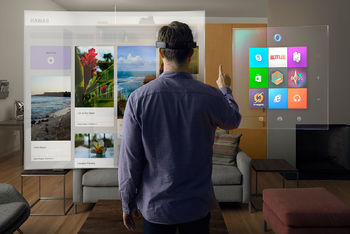Microsoft HoloLens: Difference between revisions
Xinreality (talk | contribs) No edit summary |
Xinreality (talk | contribs) No edit summary |
||
| Line 1: | Line 1: | ||
{{Device Infobox | {{Device Infobox | ||
|image= | |image=[[File:microsoft hololens1.jpg|350px]] | ||
|Type=[[Augmented Reality]] Headset | |Type=[[Augmented Reality]] Headset | ||
|Creator= | |Creator= | ||
Revision as of 02:01, 13 February 2015
| Microsoft HoloLens | |
|---|---|

| |
| Basic Info | |
| Type | Augmented Reality Headset |
| Developer | Microsoft |
| Manufacturer | Microsoft |
| Website | Microsoft HoloLens |
| System | |
| Storage | |
| Display | |
| Image | |
| Optics | |
| Tracking | |
| Audio | |
| Connectivity | |
| Device | |
Property "Type" (as page type) with input value "Augmented Reality]] Headset" contains invalid characters or is incomplete and therefore can cause unexpected results during a query or annotation process.
Windows HoloLens is a Augmented Reality device developed by Microsoft. HoloLens was announced in Windows 10 Event on January 21st, 2015. HoloLens is a smart glasses device worn over your eyes. Unlike Oculus Rift, the eye-piece component of HoloLens is transparent. It is able to project virtual content over real world objects. One of the example Microsoft used was Windows-like interfaces were projected onto walls and furniture. Users can interact with these projections with gestures and voice commands.
Windows HoloLens runs a self-contained Windows 10 computer. It features HD 3D optical head-mounted display, spatial sound projection and advanced sensors to allow its users to interact its AR applications through head and eye movements, gestures and voices.

